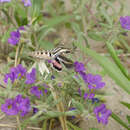Habitat
fornecido por University of Alberta Museums
Open areas such as meadows, gardens, roadsides, edges and clearings.
- licença
- cc-by-nc
- direitos autorais
- University of Alberta Museums
Life Cycle
fornecido por University of Alberta Museums
Adults are on the wing from mid-summer to early fall. Although mainly nocturnal and attracted to light, they can also be found visiting flowers at during the day or at dusk. The White-lined sphinx is mainly a southern species, which moves northward each year, and probably does not overwinter in Alberta. Earlier arrivals from the south appear to produce a generation that make up most of the specimens that are found here. Numbers of adults as well as the distance north that specimens are found may vary greatly from year to year.
- licença
- cc-by-nc
- direitos autorais
- University of Alberta Museums
Trophic Strategy
fornecido por University of Alberta Museums
Polyphagous. A wide variety of herbs, shrubs and even trees in many families have been recorded as hosts. In Alberta it has been recorded as larvae on fireweed. Elsewhere, it has been found on apple, Amaranthus, beets, Brassica rapa, Chenopodium, lettuce, Evening Primrose (Oenothera) and many other plants (see Handfield, 1999 for a list). On the other hand, Native people in the American southwest considered the larvae a delicacy and used them in ceremonial stews.
- licença
- cc-by-nc
- direitos autorais
- University of Alberta Museums

